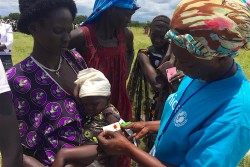メニュー 閉じる
- TOP
- はじめてのかたへ
- よくあるご質問/お問合せ
-
ユニセフについて
-
世界の子どもたちを知る
-
ユニセフハウス展示見学
- 協定地域組織(地域における活動)
- イベント一覧
- お知らせ一覧
- ご支援者(個人)の皆様へ
ユニセフについて
世界の子どもたちを知る
ユニセフハウス展示見学
 寄付方法のご案内
寄付方法のご案内
 ご寄付による支援例・成果
ご寄付による支援例・成果
 領収書
領収書
 その他のご協力方法
その他のご協力方法
 個人のみなさま
個人のみなさま
 学校・園のみなさま
学校・園のみなさま
 大学生ボランティア
大学生ボランティア
【2017年11月6日 ローマ/ジュバ(南スーダン)発】
南スーダンは収穫期を迎えているものの、紛争が国内のほとんどの地域で続き、ハイパーインフレーションが起こっているために、多くの人々が食糧を得られず、飢餓が終わることはないと、本日政府およびユニセフ(国連児童基金)、FAO(国連食糧農業機関)、WFP(世界食糧計画)ならびに人道支援のパートナー団体により発表された、総合的食料安全保障レベル分類 (Integrated Food Security Phase Classification、略称IPC)の最新報告書は指摘しています。
 |
|
© UNICEF/UN0120044/Makundi |
|
栄養不良の検査を受ける子ども。 (2017年8月撮影) |
全国で深刻な食糧不足の状態にある人々の数は6月時点の600万人から、10月―12月には480万人に減少すると予測されます。しかし、この480万人という数字は昨年同時期より140万人多く、その増加数の多くは「緊急」段階(IPCの5段階分類の第4段階)に分類されます。
食糧不足の状況は、2018年初頭から悪化し、”hungry season”あるいは ”lean season”と呼ばれる世帯が食糧の底をついた状態で次の収穫を待つ時期が、例年より3カ月早く訪れると予測されます。多くの人々は、”lean season”に対応するすべを持たず、彼らの置かれている状況はさらに脆弱化すると予測されます。
栄養不良も、昨年同時期と比較して悪化しています。調査によれば、栄養不良に陥っている人の割合は、ほとんどの地区でWHOが栄養不良の危機的レベルと設定している15%を超えており、いくつかの地区では30%以上になっています。
2018年には5歳未満児110万人以上が栄養不良に陥り、そのうち30万人近くが重度の栄養不良で死に至る危険性が高いと推定されます。
「南スーダンではあまりに多くの子どもたちが飢えています。飢えに苦しむ人の5人に1人は5歳未満の子どもです」とユニセフ・南スーダン事務所代表マヒンボ・ムドエは述べました。「そのために、多くの命が危険に晒される栄養危機が起きているのです」
政情不安により食糧の生産が妨げられる状態が続き、市場は混乱したままです。経済の悪化と相まって、食糧価格の極端な高騰を招いています。モロコシ、トウモロコシや小麦粉などの主食の穀物の大袋の値段は、昨年と比較して281%上昇、”lean season”のピークの5月には560%上昇しました。
ユニセフはパートナー団体と協力して、今年すでに16万人以上の重度の栄養不良の子どもに治療を提供しました。年内に全国の20万7,000人の栄養不良に陥っている子どもへの支援を提供する予定です。ユニセフは、複数分野アプローチの一環として、75万人に安全な水を提供し、さらに23万人に衛生施設へのアクセスを提供しました。
【関連ページ】
シェアする
